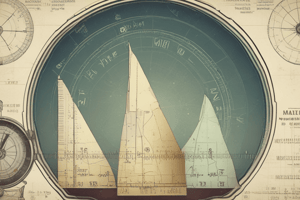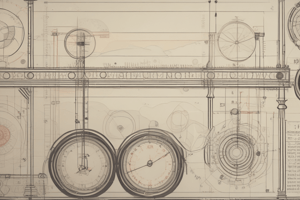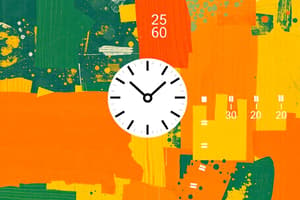Podcast
Questions and Answers
What served as the primary tool for measurement before the modern era?
What served as the primary tool for measurement before the modern era?
- Digital devices
- The human body (correct)
- Mechanical instruments
- Mathematical formulas
Which measurement represents the distance from elbow to fingertip?
Which measurement represents the distance from elbow to fingertip?
- Inch
- Yard
- Foot
- Cubit (correct)
Which unit of measurement is considered part of the English system?
Which unit of measurement is considered part of the English system?
- Kilogram
- Millimeter
- Centimeter
- Cubits (correct)
Which of the following measurements represents a larger unit in the English measurement system?
Which of the following measurements represents a larger unit in the English measurement system?
What is the primary basis of the metric system?
What is the primary basis of the metric system?
How is the yard defined in relation to the human body?
How is the yard defined in relation to the human body?
Which countries officially use the imperial/English system?
Which countries officially use the imperial/English system?
What are basic units in the metric system for length?
What are basic units in the metric system for length?
Flashcards
Ancient Measurement System
Ancient Measurement System
Used the human body as a measuring tool, with units like cubit, foot, and inch.
Cubit
Cubit
A measurement from the elbow to the tip of the middle finger.
Foot (measurement unit)
Foot (measurement unit)
Measurement from the heel to the tip of the big toe.
Inch
Inch
Signup and view all the flashcards
Hand Span
Hand Span
Signup and view all the flashcards
Yard
Yard
Signup and view all the flashcards
Metric System
Metric System
Signup and view all the flashcards
Imperial/English System
Imperial/English System
Signup and view all the flashcards
Study Notes
Early Measurement Systems
- Human body parts were primary tools for measurement pre-modern era.
- This system was universal, accessible, and practical for daily life.
Non-Standard Units of Measurement
- Cubit: Measurement from elbow to middle fingertip (used in ancient Egypt, Mesopotamia).
- Foot: Measurement from heel to toe.
- Inch (thumb): Width of a thumb from base to first knuckle.
- Hand span: Distance between thumb and pinky finger tips spread out.
- Pace: Distance covered while walking at a consistent speed.
- Yard (arms span/fathom): Distance between outstretched fingertips.
English System of Measurement
- Originated from Roman and Anglo-Saxon practices.
- Based on body parts and local standards, often inconsistent.
- Basic units for length: inch, foot, yard, mile.
Metric System
- Emerged in late 18th century France.
- Aims for a universal and consistent system based on decimal units.
- Units for length: meter, centimeter, millimeter, kilometer.
- Units for weight: kilogram, milligram, centigram, gram.
- Units for capacity: liter, kiloliter, centiliter, milliliter.
- Units for time: hours, minutes, seconds.
Differences Between Systems
- Only three countries (US, Myanmar, Liberia) officially use the English/Imperial system.
Studying That Suits You
Use AI to generate personalized quizzes and flashcards to suit your learning preferences.





